Crop Tips: Poinsettias

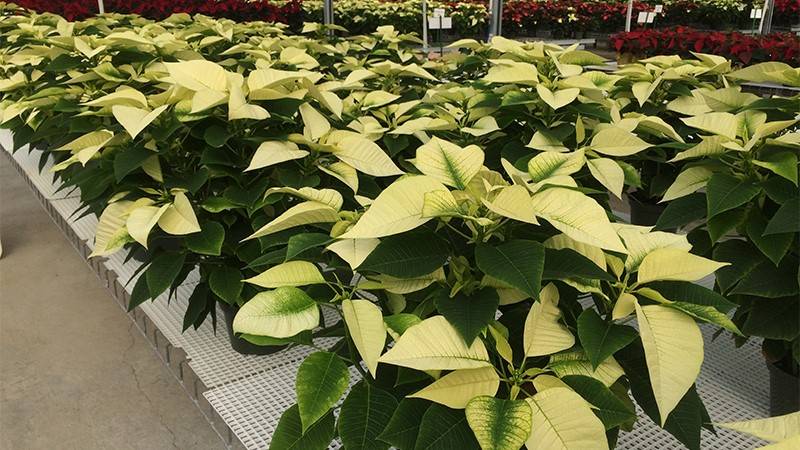
Growing poinsettias can be challenging considering they are sensitive to the environment, diseases, insects and watering. Not to mention that the crop is grown for up to 6 months, which means a greater chance that problems can develop.
In this article, we will discuss some of the common tips for propagating and growing today’s poinsettia cultivars.
Reception of cuttings
If you start with unrooted cuttings, make sure the rooting area is sanitized from top to bottom, including ceilings, benches, floors and containers. Any fungus gnats found in the area must be controlled as their populations can explode under mist, they feed on developing roots to damage/destroy cuttings, and fungus gnats serve as vectors for plant pathogens. Once cuttings arrive, stick them as soon as possible. If this is not possible, store the cuttings at a cool 50°F (10°C) to reduce water loss from the leaves. If they start to wilt before sticking, the mortality of the cuttings will greatly increase.
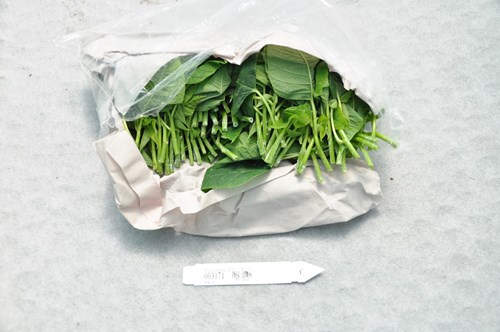
Rooting
Cuttings can be stuck into PRO-MIX® FPX AGTIV™ STIMULATE™ or PRO-MIX® HP AGTIV™ AMPLIFY™ in cell trays or paper-wrapped pots, in stabilized media or foam products. It helps to apply a rooting hormone to speed the callusing and rooting of the cuttings, then immediately place them under mist to avoid desiccation. If your irrigation water has a moderate to high alkalinity, injecting acid will reduce alkalinity and pH climb in the growing medium, however, beware that too much acid may damage foliage. Consider partially shading the cuttings to keep cuttings cool to minimize desiccation. Watch for bacterial and fungal diseases during propagation. If necessary, treat with appropriate fungicide and/or bactericide program to reduce loss.
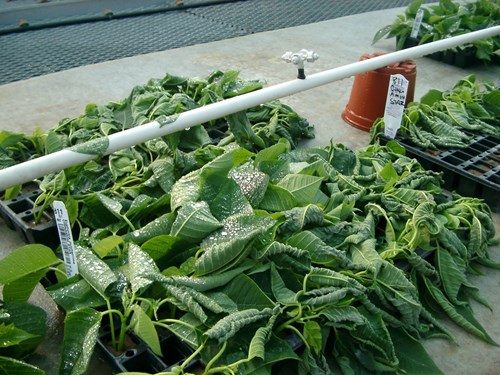
Callusing of cuttings will occur within 5-7 days. Once callused, reduce misting and begin applying fertilizer through the mist that is matched with your water quality at a rate of 100-150 ppm nitrogen, 3-4 times per week, so the nutrient reserves are not used up within the cuttings. Root emergence should begin by day 10 and misting should be further reduced to encourage better rooting. Discontinue mist by day 14 and then constantly feed rooted cuttings with water-soluble fertilizer at a rate of 150 ppm nitrogen. Young plants should be ready to transplant 23-28 days after sticking.
Finishing: Growing Medium and Fertility
Transplant young poinsettias into a high porosity growing medium such as PRO-MIX® HP AGTIV™ AMPLIFY™. Begin constant feeding with a fertilizer that has been matched to your water quality at a constant rate of 200-250 ppm nitrogen. Growing medium pH should be 5.7-6.2 and the E.C. between 1.5-2.0 mmhos/cm. Less vigorous or slower rooting cultivars could be fertilized at slightly lower rates as salts may slowly climb. Make sure calcium and magnesium are supplied at constant rates of 50-100 ppm and 25-40 ppm, respectively. Remember to monitor the growing medium pH since cal-mag or calcium-based fertilizers may cause the growing medium pH to rise. Calcium deficiency is most likely to occur at the end of the crop cycle during bract formation and coloring. Fertility rates should be reduced in November as active growth almost stops and bracts begin to color and are maintained until the end of the crop cycle.
Pinching
Once the newly transplanted poinsettias begin to grow, stems can stretch significantly between leaves (referred to as internodes). Stretched internodes lead to uneven bract height at the end of the crop cycle and weak branches. It is recommended to apply a plant growth regulator later in the propagation stage and again after transplant, so internodes are close together and subsequent branches emerge close together on the stem. Pinching should occur once the poinsettia roots reach the edge of the pot (12-14 days after transplanting). Pinch-to-leaf count based on the number of bracts desired (i.e. leave 6-7 leaves to ensure a plant with 6 bracts). Remember high bract count will create wider plants with smaller bracts and with more common stem breakage.
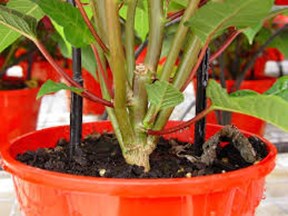
To improve uniformity of branching it is best to maintain high humidity just before pinching and up to two weeks after pinching. Occasional misting with booms, overhead sprinkling or wetting the floors will help increase humidity. This will also help reduce heat which can impact branching quality.
Growing Environment
To avoid getting foliage wet, it is best to water with drip irrigation. If watering is done from the top, remember to water early in the day so the foliage has a chance to dry. Also, overhead watering has been found to help strengthen the branches. Maintain day temperatures from 75-85°F (24-30°C) and night temperatures from 61-72°F (16-22°C). Avoid night temperatures above 73°F (23°C) from September 1 – October 10 as flower initiation will be delayed.
Watering and Pythium
Watering should be thorough, with proper dry down between irrigations. Allow the growing medium surface to dry down between irrigations since excessive moisture and wet growing medium surface promote algae growth and attract shore flies and fungus gnats. Pythium can be a problem especially as the days shorten and sunlight is limited toward the end of the production cycle. With shorter days and lower light intensity, watering frequency must be reduced, and plants must be allowed to dry out. Airflow should be encouraged and plant spacing is critical to allow stagnant humidity to move out of the plant canopy. Keeping the growing medium warm also aids in faster dry down of the growing medium and the reduction of Pythium. If possible, try to build a robust root system early in the crop cycle to help reduce loss from Pythium at the end of the crop cycle.
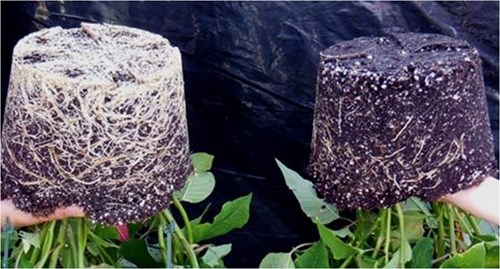
Cold Growing
Growing cold to reduce heating costs in the late fall can be done, but there are compromises to be considered. First, try to get the plant up to finish size before cooling as plant growth will slow. Growing cold at night means greenhouse temperatures are closer to the dew point; therefore, condensation can form on poinsettia leaves making the ideal environment for Botrytis.
Bract size is often reduced, and growth slows to the point it may delay finish. Not all cultivars do well with growing cold at night, i.e. white bracts have a brownish or greenish cast to them. Pythium tends to be more of a problem due to the slower drying of the growing medium and ease of overwatering.
If you have further questions about growing a successful poinsettia crop, make sure you contact your plant supplier as many can provide helpful tips.
Source:
Gary Vollmer. "Strategies for Growing Selecta Poinsettias. Poinsettias of Pennsylvania Trial and Open House", November 2014.